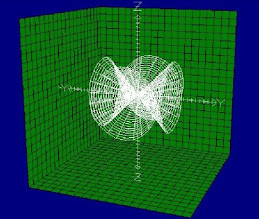(x+y)0 = 1
(x+y)1 = 1.x + 1.y
(x+y)2 = 1.x2+ 2.xy + 1.y2
(x+y)3 = 1.x3+ 3.x2y + 3.xy2 + 1.y3
But where do these coefficients come from? You can just be satisfied by the result algebraic calculation, or you could look for geometric representations. For instance, a nice geometric explanation is given at the www.mathaware.org site.
 |
| Geometric proof of square binomial (original at The Geometry of the Binomial Theorem, Math Awareness Month site) |
 |
| Geometric proof of cubic binomial (original at The Geometry of the Binomial Theorem, Math Awareness Month site) |
This suggested impossibility prompted me to have a closer look at geometric representations of binomial expansions. As a matter of fact a number to the fourth power x4 is just a number, but it is also a square x4 = (x2)2. And there is no impossibility in representing numbers and squares geometrically, so the suggested impossibility is only an impossibility along the common line of thought, which sees cubic expansions as volumes. Along another line of thought, which seems to have been unnoticed, cubic expansions can be seen as areas, and then geometric representations of higher degree binomials become possible. The following figures illustrate this fact for the special case where x+y is normalized to 1 (for arbitrary x+y, one just has to rescale the figure each time, the pattern remains the same).
For the binomial (x+y)1 = 1.x + 1.y, we can divide a unit square into two rectangles, one rectangle of area x and one rectangle of area y, see Figure 1.
For the binomial (x+y)2 = 1.x2+ 2.xy + 1.y2, we can divide the unit square into two squares, one of area x2 and one of area y2, plus two rectangles of area xy, see Figure 2.
For the binomial (x+y)3 = 1.x3+ 3.x2y + 3.xy2 + 1.y3, we can divide each of the previous squares and rectangles into proportions x and y, giving eight rectangles, one of area x3, one of area y3, plus three rectangles of area x2y and three rectangles of area xy2, see Figure 3.
For the binomial (x+y)4 = 1.x4+ 4.x3y + 6.x2y2 + 4.xy3 + 1.y4, we can again divide each of the previous squares and rectangles into proportions x and y, giving one square of area x4, one of area y4, four squares and two rectangles (giving six) of area x2y2, four rectangles of area x3y and four rectangles of area xy3, see Figure 4.
And we could go further indefinitely, doodling areas of incrementing powers, just in 2D, without any reference to unintuitive hyperspaces.






